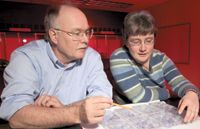- Case-Based Roundtable
- General Dermatology
- Eczema
- Chronic Hand Eczema
- Alopecia
- Aesthetics
- Vitiligo
- COVID-19
- Actinic Keratosis
- Precision Medicine and Biologics
- Rare Disease
- Wound Care
- Rosacea
- Psoriasis
- Psoriatic Arthritis
- Atopic Dermatitis
- Melasma
- NP and PA
- Skin Cancer
- Hidradenitis Suppurativa
- Drug Watch
- Pigmentary Disorders
- Acne
- Pediatric Dermatology
- Practice Management
- Prurigo Nodularis
- Buy-and-Bill
Article
Artificial skin could mimic normal skin
Potsdam, N.Y. — Researchers at Clarkson University are working on a skin substitute that they hope one day will heal and function like normal skin. As such, physicians could use it successfully to treat large burns or areas of surgical reconstruction.

Problems with traditional skin grafts include scarring, infection and poor adhesion. Furthermore, creating large amounts of skin in the laboratory by isolating individual epidermal cells, then expanding their numbers in culture, results in poorly matched grafts that lack hair follicles and pores.
To overcome these shortcomings, the Clarkson team must successfully create a biodegradable scaffold for skin cells to grow around that also can release cytokines to improve skin growth and promote wound healing.
Enzymes the catalyst To accomplish this goal, researchers are attempting to incorporate peptides and cytokines into the scaffolding material.
"Instead of using an organic or inorganic catalyst, we are using enzymes as our catalyst," says Anja Mueller, Ph.D., a polymer chemist and assistant professor of chemistry at Clarkson. "Since enzymes always work in very mild conditions, which are basically the same conditions in which the human body works, we can incorporate those signals that (cause) the skin to grow properly in the synthesis itself."
Unlike the traditional method of assembling a scaffold first, then adding cytokines later in the process, she says her approach will allow for a steadier, more controlled release of cytokines. At the same time, her method will avoid toxic catalysts and organic solvents that could leave residual toxic compounds in the skin scaffold.
"That's the novel element that would make a big difference if we can get it to work well," Dr. Woodworth says. So far, he says, "We have some good preliminary results."
According to Dr. Mueller, "One of the most exciting syntheses that I have developed is actually a polysaccharide synthesis. Polysaccharides are similar materials to starch and cellulose. In general, they're extremely hard to synthesize. They simply have too many reactive groups that could do everything at the same time, and one wouldn't get any control over the structure. If you don't get any control, you don't have a good synthesis. Then the purification is very difficult and the yield extremely low."
The enzymes with which the researchers are working, however, achieve yields of 80 percent to 90 percent.
"It's a one-step reaction," Dr. Mueller adds. "And it's an easy enzymatic reaction and an easy purification."
Stability a challenge Challenges that remain include stabilizing the polysaccharide-based scaffold.
"This polysaccharide is basically a viscous liquid," Dr. Mueller explains. To make it strong enough to support skin growth, she says, "We are reacting this polysaccharide with other biocompatible materials such as polyethylene glycol. At that point, we get much stronger materials that are still biocompatible. And polysaccharides are very good as a material because they resemble the conditions in (skin) cells. So in some ways, they're actually more biocompatible than some of the so-called biocompatible materials."
While Dr. Mueller works on the scaffolding and catalyst, Dr. Woodworth is zeroing in on which cytokines will be most effective in helping the graft heal and restore normal function. In this regard, he is focusing on several cytokines, including epidermal growth factor (EGF) and vascular endothelial growth factor (VEGF).





